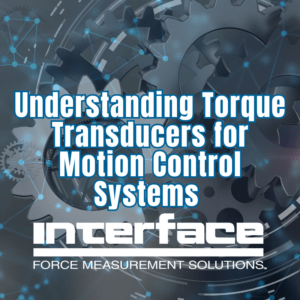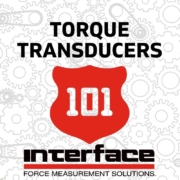Understanding Torque Transducers for Motion Control Systems
 A motion control system is an integrated set of components that work together to control the movement of a machine or device. It typically includes four main elements: controllers, sensors, actuators, and drives.
A motion control system is an integrated set of components that work together to control the movement of a machine or device. It typically includes four main elements: controllers, sensors, actuators, and drives.
Torque transducers are essential components in motion control systems. They are important in controlling rotating machinery by providing real-time feedback on the applied torque accurately and efficiently.
Selecting the right torque transducer for a motion control system depends on several major factors, including use case, measurement range, accuracy requirements, speed, and environment.
Industry use cases of motion control systems require different torque measurement capabilities. For example, a robotic arm may need a torque transducer with a high resolution and fast response time. In contrast, a wind turbine may need a torque transducer with a high torque capacity and a long lifespan.
Motion control systems have the same basic goal: to control the movement of a machine or device in a precise and controlled method. Evaluation of the type of torque transducer for your motion control system is important based on type, measurement capacities, accuracy, and speed. Do you need a rotary torque transducer or a static device, known as a reaction torque transducer?
Torque Transducers for Motion Control Systems
Rotary torque transducers are designed to be mounted directly on a rotating shaft. These dynamic transducers are ideal for measuring torque in motors, pumps, and turbines.
Reaction transducers measure the torque applied to a stationary object. These static transducers are ideal for measuring torque in automotive applications such as brakes and clutches.
The torque transducer should withstand the environmental conditions it will be used, including factors such as temperature, vibration, and chemical exposure. These details should be easily identifiable in a review of the transducer’s specifications.
TIP: Use Interface’s Torque Transducer Selection Guide for easy device comparisons.
Why are torque transducers used in motion control systems?
Closed-loop control: Torque transducers enable closed-loop control of motors and drives. By measuring the actual torque output, the control system can compare it to the desired torque and adjust the motor speed or power output to maintain it. This ensures precise and consistent operation of the system, regardless of load variations.
Overload protection: Torque transducers can protect motors and other components from damage caused by excessive torque. By monitoring the torque in real-time, the system can shut down the motor or activate other protective measures if the torque exceeds a predetermined safe limit. This prevents costly equipment failures and downtime.
Optimization and efficiency: Torque transducers help optimize the performance of motion control systems by providing valuable data for analysis and improvement. Engineers can identify areas where the system can be more efficient by measuring the torque at different operating points. This can lead to reduced energy consumption, improved productivity, and increased product quality.
Safety: In safety-critical applications, torque transducers play a vital role in ensuring the safe operation of machinery. The system can take appropriate action to prevent accidents or injuries if the torque exceeds a safe limit by providing data on the torque applied to safety-related components.
Motion Control Applications
Here are four examples of how torque transducers are used in different types of motion control systems:
ROBOTICS: Torque transducers are used to control the movement of robotic arms with high precision. They ensure the robot arm applies the correct force to move objects without damaging them.
MACHINERY: Torque transducers control the spindle speed and feed rate of CNC machines, ensuring accurate and consistent machining operations.
ENERGY: Torque transducers are used to monitor the torque output of wind turbines and optimize their performance. This helps maximize energy production and ensure the safe operation of the turbines.
EV: Torque transducers are used in the drivetrains of electric vehicles to control the torque delivered to the wheels. This enables efficient and smooth acceleration and deceleration.
Should you use torque couplings instead of key shafts in motion control systems?
If your motion control system demands high precision, efficiency, and reliability, removing key shafts and employing torque couplings might be beneficial.
Keyless solutions can reduce downtime and associated costs in applications requiring frequent maintenance. Compact torque couplings can be a better fit than bulky key shafts in tight spaces.
If perfect shaft alignment is challenging, flexible torque couplings can compensate for misalignment and prevent potential problems.
TIP: Visit Torque Coupling Selection Guide for options.
Reviewing your use case to determine if key shafts are necessary for your motion control system is important. There are advantages to keeping key shafts. Replacing key shafts with torque couplings can offer several advantages, including:
- Elimination of keyways: Keyways are slots cut into the shaft and hub to accommodate a key. This weakens the shaft and can lead to stress concentrations and fatigue failures. Torque couplings eliminate the need for keyways, improving the strength and integrity of the shaft.
- Reduced maintenance: Keys can wear and loosen over time, requiring periodic maintenance and replacement. Torque couplings, on the other hand, are generally maintenance-free.
- Improved performance: Torque couplings can transmit torque more efficiently than keys. This can lead to improved performance and efficiency in the overall system.
- Reduced noise and vibration: Keys can cause noise and vibration, especially at high speeds. Torque couplings can help to reduce noise and vibration levels.
- Simplified assembly and disassembly: Keys can be difficult to install and remove, especially in tight spaces. Torque couplings are generally easier to assemble and disassemble.
- Increased flexibility: Some torque couplings can accommodate misalignment between shafts, which can be helpful in applications where perfect alignment is difficult to achieve.
Whether to use torque couplings to replace key shafts depends on the specific application. However, torque couplings can offer significant advantages in strength, performance, and ease of use in many cases.
Torque transducers are versatile tools that play a vital role in various motion control systems. They provide accurate and reliable data on the applied torque, enabling closed-loop control, overload protection, system optimization, and enhanced safety.
ADDITIONAL RESOURCES
Trends in Torque Transducer Applications in the Auto Industry
Interface Introduces New Torque Coupling Guide
Torque Transducers and Couplings are the Perfect Pairing
Miniature Torque Transducers 101
Choosing the Right Torque Transducer
A Comparison of Torque Measurement Systems: Download the white paper.







